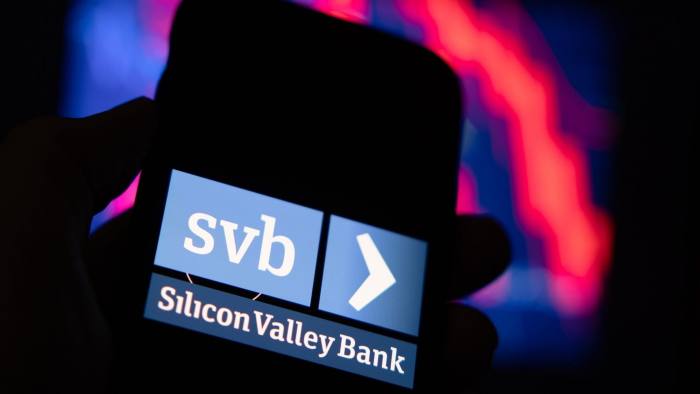
SVB crash is a red flag on rate risk
 The collapse of SVB has belatedly put the issue front of mind for investors worldwide © Bloomberg
The collapse of SVB has belatedly put the issue front of mind for investors worldwide © Bloomberg We’ll send you a myFT Daily Digest email rounding up the latest Banks news every morning.
The writer is managing partner and head of research at Axiom Alternative Investments
Of all the ways a bank can die, the route pursued by Silicon Valley Bank on the way to implosion appears to have been one of the most reckless.
Banks exist to take and manage liquidity, interest rate and credit risks. It is therefore stunning to hear that a US bank has just failed because it invested much of its swollen base of deposits, mostly redeemable at demand, into a long-term, held-to-maturity bond portfolio without any interest rate hedge.
A failure this size will raise many questions — about contagion risk, supervisory or regulatory failures, the impact on the venture capital market and so on — but the root cause is a global phenomenon: interest rates have gone up quickly everywhere and it is reasonable to ask if a similar high-speed crash could happen elsewhere.
There are three ingredients to this explosive recipe: volatile deposits, high interest rate risk on the asset side and insufficient hedges. Once the ingredients are there, it is a movie you have seen before: a deposit flight materialises, long-term assets have to be sold at a loss and, absent hedges, banks fail.
With this framework in mind, let us compare the vulnerabilities of three large banking markets — the US, the eurozone and Japan. The level of deposits is key. What do banks do when they have too many deposits? Buying long-term bonds is a common tactic.
European banks, scarred by losses during the eurozone crisis, have learned the hard way that there is no free lunch to be gained from such a strategy — they know that their bond books should be hedged. Since the first European banking regulatory stress tests in 2009, banks have been tested for their sensitivity to falls in value of government bonds. Poor tests indirectly led to the bailouts of Italian lender Monte dei Paschi.
Is it possible to quantify such risk and the impact of hedges banks use for the three banking markets? Well, the fundamental structures of deposit markets are similar. For example, the aggregate share of insured deposits is similar in the eurozone and the US at about 58 per cent. But, compared with Europe or Japan, the US experienced a sharper rise during the Covid pandemic in deposit growth. A slowing to long-term average growth seems logical.
Moreover, the unwinding of the central bank bond-buying programmes of recent years, known as quantitative tightening, is happening faster in the US. This reduces the amount of money in the financial system, thus mechanically decreasing bank deposits. EU bank rules also give a preferential treatment to retail depositors, irrespective of whether the deposits are insured or not. Hence, US deposits are slightly more vulnerable, in my view.
Faced with a similar problem (investing massive deposit inflows despite an expensive Japanese government bond market increasingly owned by the central bank), Japanese banks diversified by investing abroad. In other words, they adapted themselves to the world of negative rates and lossmaking deposits. But some risk always remains.
Recommended
Behind the Money podcast23 min listenWhy SVB’s collapse is not a 2008 repeat
And assessing this is a tricky exercise, mostly because it requires an accurate understanding of the behaviour of depositors. An on-demand deposit paying no interest from a loyal client can look like a 5-year debt and used as a hedge against a 5-year asset. But if the client changes their mind, the hedge immediately evaporates. It is therefore crucial that banks model their clients’ behaviour properly.
To quantify the risks, an international framework (the so-called IRRBB for interest rate risk in the banking book) was introduced — but largely voided by President Donald Trump for US banks with assets under $250bn. What do the numbers tell us?
The eurozone looks like a safe place. Overall, an increase in benchmark rates of about 2 percentage points could lead to a decrease in the value of the equity of banks in the bloc of about 4 per cent. But there is dispersion and apparently size matters. The German Bundesbank estimated that the large systemic lenders had a risk of potential equity hit of about 6 per cent but for co-operative or saving banks it was 22 per cent. Numbers for the US are surprisingly hard to find, and even some systemic banks do not report them. I think the potential risks are higher than in Europe.
But the outlier is Japan, which adopted the global regulatory framework on the issue in 2018. Even only using test of a 1 percentage point rate rise shock, the estimated hit to equity is 18 per cent. And this average number, again, hides very large differences between sophisticated large institutions (10 per cent) and smaller players such as the regional Shinkin co-operative banks (a whopping 30 per cent).
Higher rates in Japan will need to be introduced with extreme caution. This has been long acknowledged in markets. The collapse of SVB has now belatedly put the issue front of mind for investors worldwide.
Video: Fractured markets: the big threats to the financial system {"focus":["29e67a92-a3b8-410c-9139-15abe9b47e12","456d01ad-ea50-4aa7-8d7f-b9737216d453","66f1abb1-d35e-4d98-88db-b7a943104e84","738ba631-9a48-4b3f-9c5f-02a7cb9639d8","c91b1fad-1097-468b-be82-9a8ff717d54c","6da31a37-691f-4908-896f-2829ebe2309e","f021ef0a-e3a5-3530-9394-21a1eaf9f3f6","1248b3d3-1d4c-4454-af23-c0b4707ed412","18c92e0c-d6dc-42f9-8283-0dd3de42b988","82645c31-4426-4ef5-99c9-9df6e0940c00","b062fd6b-01fa-4049-a1bc-092f9f43c307","c47f4dfc-6879-4e95-accf-ca8cbe6a1f69","ec4ffdac-4f55-4b7a-b529-7d1e3e9f150c"],"brandConcept":"f021ef0a-e3a5-3530-9394-21a1eaf9f3f6","authorConcepts":["77d4a2ef-2239-49b2-ae66-6d0c49598a59"],"displayConcept":"66f1abb1-d35e-4d98-88db-b7a943104e84"}Copyright The Financial Times Limited 2023. All rights reserved.Reuse this content (opens in new window) CommentsJump to comments sectionPromoted Content Follow the topics in this article- Jérôme Legras Add to myFT
- Markets Insight Add to myFT
- Global Economy Add to myFT
- US banks Add to myFT
- Banks Add to myFT
Owl Media Group takes pride in providing social-first platforms which equally benefit and facilitate engagement between businesses and consumers and creating much-needed balance to make conducting business, easier, safer, faster and better. The vision behind every platform in the Owl Media suite is to make lives better and foster a healthy environment in which parties can conduct business efficiently. Facilitating free and fair business relationships is crucial for any thriving economy and Owl Media bridges the gap and open doors for transparent and successful transacting. No advertising funds influence the functionality of our media platforms because we value authenticity and never compromise on quality no matter how lucrative the offers from advertisers may seem.
Originally posted on: https://www.ft.com/content/02576e3c-67c8-4a7c-86b3-bc9c270a90b6